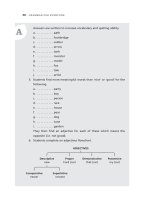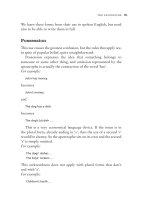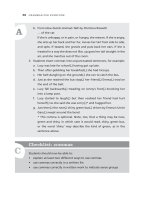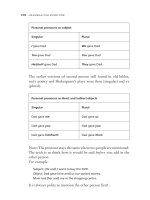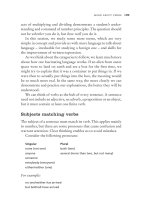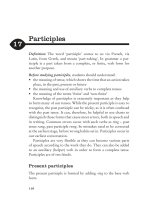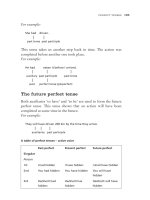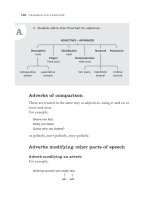Grammar for everyone part 14
Bạn đang xem bản rút gọn của tài liệu. Xem và tải ngay bản đầy đủ của tài liệu tại đây (113.94 KB, 7 trang )
We learn these forms from their use in spoken English, but need
also to be able to write them in full.
Possession
This use causes the greatest confusion, but the rules that apply are,
in spite of popular belief, quite straightforward.
Possession expresses the idea that something belongs to
someone or some other thing, and omission represented by the
apostrophe is actually the contraction of the word ‘has’.
For example:
John has money.
becomes
John’s money.
and
The dog has a dish.
becomes
The dog’s (a) dish …
This is a very economical language device. If the noun is in
the plural form, already ending in ‘s’, then the use of a second ‘s’
would be clumsy. So the apostrophe sits on its own and the second
‘s’ is simply omitted.
For example:
The dogs’ dishes …
The boys’ careers …
This awkwardness does not apply with plural forms that don’t
end with ‘s’.
For example:
Children’s teeth …
81
t h e A p o s t r o p h e
A
In spoken language, to avoid ambiguity, we can fall back on the
longer form.
For example:
‘The horse’s trainer’ sounds the same as ‘the horses’ trainer’, so it
is clearer to say ‘the trainer of the horses’ or similar.
If a surname ends in ‘s’, as in Jones or Fields, the form ‘s
pronounced es’ (or ‘is’) is often used in speech but in writing it is
proper to use the apostrophe alone, as with plurals.
For example:
The Jones’ Mercedes
Avoiding confusion
The apostrophe is traditionally used for clarity in abbreviations
and other forms.
For example:
The MSc’s were awarded next.
There are two s’s in ‘grass’.
11.1 Activities: apostrophes
1. a. Students are given contractions and they supply the full form,
first orally, then in writing:
he’ll, we’re, can’t, won’t, would’ve, didn’t, I’d, I’ll, they’d,
don’t
b. Students do the reverse giving the contracted form orally and in
writing.
2. Students play an oral concentration game. The teacher gives a phrase
and students raise both arms if the ending is ‘apostrophe s’, as in
the girl’s mother, or one arm for an apostrophe only, as in Captain
Sykes’ horse, or the boys’ desks. Students must listen carefully for
the plurals.
82
G r A M M A r f o r e V e rY o n e
C
A
a. the headmaster’s office
b. a bee’s sting
c. two cars’ headlights
d. the class’s results
e. those dogs’ bones
f. the science teacher’s study
g. our museum’s corridors
h. the king’s horses
i. the horses’ harnesses
j. my mother’s hat
3. Students write on the board, or in their books, abbreviations and
other usages of the apostrophe.
MBA’s, PhD’s, BBQ’s, do’s and don’t’s, dot your i’s (this would say ‘is’
without the apostrophe)
Checklist: apostrophes
Students should now be able to use the apostrophe for:
• showing possession of something belonging to:
− one person or thing, e.g. grandma’s glasses
− more than one person or thing, e.g. the cars’ roofs (n.b. not
‘rooves’)
− one or more person or thing that already ends in ‘s’, e.g. Mr
Jones’ pen
• indicating omission of a letter or letters in contractions, e.g. will’ve,
haven’t, and describe clearly how to use the apostrophe in each of
the instances so far learnt
83
t h e A p o s t r o p h e
Commas
Definition: The word ‘comma’ has come to us through Latin,
from the Greek komma meaning ‘a piece cut out’, i.e. separated.
In this case, the comma separates groups of words.
Before learning about commas, students should:
• know the form of simple sentences
• know the correct punctuation for kinds of sentences
• have the ability to use both of the above in writing
There are several uses of the comma that students should now
learn and practise. Also shown below are one or two that could be
studied in more detail later. Knowing the functions of the comma
is essential, not just for reading and writing well, but for accuracy
and avoiding ambiguity.
With the introduction of the holistic approach to writing, many
educationists adopted the attitude that ‘such things as spelling and
punctuation were of less importance than a total impression of its
quality’. The results of this phase in educational history are now
reflected in some of the poor standards and misleading written
information that we see today. With sound early instruction,
accurate and meaningful writing should result.
The presence or absence of a comma can totally alter the
meaning of a sentence, and a comma put in the wrong place can
result in misunderstanding and embarrassment.
Choose an appropriate time to point this out, using examples
such as the following:
The car rolled about 100 metres from the corner.
or The car rolled, about 100 metres from the corner.
12
84
The activities at the end of this section not only provide
practice in the uses of the comma, but also give opportunities
to develop the imagination, expand vocabulary and read with
expression.
The comma separates
It does this in several ways.
Items in a list
It marks off items in a list. There is usually no comma preceding
the last item, as it is replaced by the word ‘and’.
For example:
I emptied my pocket and found a locker key, a 20-cent piece, a Mintie,
a small screw and a piece of string.
Sense groups
It separates sense groups. This applies to phrases and clauses. At
this stage students will probably not understand these terms, but
they can be shown how the comma indicates where we should
pause when reading aloud. We may raise our voice a little at the
comma, to show that we have not yet reached the end of the
sentence. We might use this pause to take a quick breath.
For example:
He slipped into the classroom, just before the bell.
Or to mark off an extra piece of information:
The driver, Mr Cramp, pulled back the gearstick.
When writing, we need to imagine how we would like someone to
read what we have written and use commas accordingly.
Sometimes the positioning of commas is extremely important
or our sentence could give quite the wrong meaning.
85
c o M M A s
